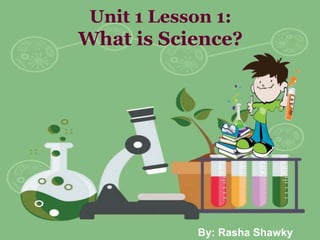
What is Science.ppt
- 1. Unit 1 Lesson 1: What is Science? By: Rasha Shawky
- 2. Unit 1 Lesson 1 What Is Science? What All Scientists Do • Science is the study of the natural world through careful observation and investigation. There are many branches of science. • Scientists use investigations to try to explain how and why things in the natural world happen. • Investigations are procedures carried out to observe, study, or test something. To answer questions about the world.
- 3. Unit 1 Lesson 1 What Is Science? What All Scientists Do • All scientists observe by using their five senses to collect information. • All scientists compare by finding ways objects and events are similar and different.
- 4. Unit 1 Lesson 1 What Is Science? • Scientists must think critically about the results of their investigations to learn more about the natural world. • Scientists collect evidence, or information, to explain observations during a scientific investigation.
- 5. Unit 1 Lesson 1 What Is Science? • Here is an example of a scientist collecting evidence: • In the 1660s, a scientist named Dr. Francesco Redi designed an experiment on maggots. • At that time, most people thought maggots grew out of rotting meat. https://www.youtube.com/watch?v=8NuiKxLAT6o
- 6. Unit 1 Lesson 1 What Is Science? • Redi put fresh meat in two jars. He covered one jar with cloth and left the other jar uncovered.
- 7. Unit 1 Lesson 1 What Is Science? • He observed the meat over many days. • He saw that flies landed on the meat in the uncovered jar. No flies landed on the meat in the covered jar.
- 8. Unit 1 Lesson 1 What Is Science? • Soon, there were maggots on the meat in the uncovered jar. There were no maggots on the meat in the covered jar.
- 9. Unit 1 Lesson 1 What Is Science? • Redi repeated the experiment many times. • Each time, he observed the same thing: Maggots grew on meat that flies landed on, but no maggots appeared on meat with no flies. • He concluded that maggots come from eggs that flies lay.
- 10. Unit 1 Lesson 1 What Is Science? • Which jar would the meat in the image below have been in? https://quizizz.com/join?gc=68013709
- 11. How to Draw Conclusions • Scientists repeat investigations over and over to draw conclusions. The conclusions are always based on evidence. • A scientist uses inferences to draw conclusions based on evidence. • Inference is an idea based on observation. • Scientists do not use feelings or opinions to draw conclusions. Unit 1 Lesson 1 What Is Science?
- 12. Observation and Inference • The eagle’s beak is very sharp( Observation/ Inference ). • It uses its beak to tear flesh into bite sized chunks ( Observation/ Inference ).
- 13. Observation and Inference • you can see water vapor ( Observation/ Inference ). • The soup is hot ( Observation/ Inference). How would you know this bowl is hot or cold without touching it ?
- 14. Observation and Inference • There are water drops on the window glass ( Observation/ Inference ). • It has been raining ( Observation/ Inference). • Somebody has sprayed water on it ( Observation/ Inference).
- 15. Opinion or Evidence? • Opinions are beliefs or judgments. • Scientists do not use opinions to draw conclusions. • Personal feelings and opinions should not affect how you do investigations or your conclusions. • You should not ignore evidence, even if you do not like what it means. Unit 1 Lesson 1 What Is Science?
- 16. Unit 1 Lesson 1 What Is Science? Knowledge Grows • Scientists communicate, or share, the results of investigations. • Other scientists can repeat the investigations and compare the results. • Scientific knowledge grows as scientists expand on one another’s ideas.
- 17. Unit 1 Lesson 1 What Is Science? • Many people work as many different types of scientists. • Astronomers: study how the universe works, using time and space relationships to investigate it • Botanists: investigate questions about plants, such as how environmental conditions impact the plant cycle • Taxonomists: identify and classify living things into categories based on specific characteristics
- 18. Unit 1 Lesson 1 What Is Science? Meet Scientists • Scientists may need to place objects or events one another in the correct sequence in order. • How do you know the order, or correct sequence, for the images below?
- 19. Unit 1 Lesson 1 What Is Science? Meet Scientists • They may also need to classify objects or events into categories based on specific characteristics.
Editor's Notes
- 2
- 3
- 4
- 5
- 6
- 7
- 8
- 9
- 10
- 11
- 15
- 16
- 17
- 18
- 19